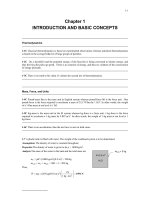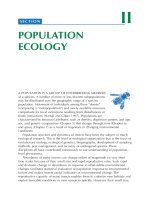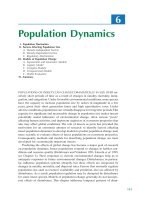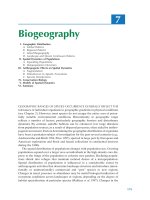Thermodynamics an engineering approach 5th ed (solution)
Bạn đang xem bản rút gọn của tài liệu. Xem và tải ngay bản đầy đủ của tài liệu tại đây (21.94 MB, 1,733 trang )
1-1
Chapter 1
INTRODUCTION AND BASIC CONCEPTS
Thermodynamics
1-1C Classical thermodynamics is based on experimental observations whereas statistical thermodynamics
is based on the average behavior of large groups of particles.
1-2C On a downhill road the potential energy of the bicyclist is being converted to kinetic energy, and
thus the bicyclist picks up speed. There is no creation of energy, and thus no violation of the conservation
of energy principle.
1-3C There is no truth to his claim. It violates the second law of thermodynamics.
Mass, Force, and Units
1-4C Pound-mass lbm is the mass unit in English system whereas pound-force lbf is the force unit. One
pound-force is the force required to accelerate a mass of 32.174 lbm by 1 ft/s
2
. In other words, the weight
of a 1-lbm mass at sea level is 1 lbf.
1-5C Kg-mass is the mass unit in the SI system whereas kg-force is a force unit. 1-kg-force is the force
required to accelerate a 1-kg mass by 9.807 m/s
2
. In other words, the weight of 1-kg mass at sea level is 1
kg-force.
1-6C There is no acceleration, thus the net force is zero in both cases.
1-7 A plastic tank is filled with water. The weight of the combined system is to be determined.
Assumptions The density of water is constant throughout.
Properties The density of water is given to be ρ = 1000 kg/m
3
.
Analysis The mass of the water in the tank and the total mass are
m
tank
= 3 kg
V
=0.2 m
3
H
2
O
m
w
=
ρV
=(1000 kg/m
3
)(0.2 m
3
) = 200 kg
m
total
= m
w
+ m
tank
= 200 + 3 = 203 kg
Thus,
N1991
m/skg 1
N 1
)m/s kg)(9.81 (203
2
2
=
⋅
== mgW
1-2
1-8 The interior dimensions of a room are given. The mass and weight of the air in the room are to be
determined.
Assumptions The density of air is constant throughout the room.
Properties The density of air is given to be ρ = 1.16 kg/m
3
.
ROOM
AIR
6X6X8 m
3
Analysis The mass of the air in the room is
kg 334.1=××= = )m 86)(6kg/m (1.16
33
Vρ
m
Thus,
N 3277=
⋅
==
2
2
m/skg 1
N 1
)m/s kg)(9.81 (334.1mgW
1-9 The variation of gravitational acceleration above the sea level is given as a function of altitude. The
height at which the weight of a body will decrease by 1% is to be determined.
0
z
Analysis The weight of a body at the elevation z can be expressed as
Wmgm z== − ×
−
(. . )9 807 3 32 10
6
In our case,
WW mg m
ss
== =0 99 0 99 0 99 9 807 .()(.)
Substituting,
m 29,539=→×−=
−
zz)1032.381.9()81.9(99.0
6
Sea level
1-10E An astronaut took his scales with him to space. It is to be determined how much he will weigh on
the spring and beam scales in space.
Analysis (a) A spring scale measures weight, which is the local gravitational force applied on a body:
lbf 25.5=
⋅
==
2
2
ft/slbm 32.2
lbf 1
)ft/s lbm)(5.48 (150mgW
(b) A beam scale compares masses and thus is not affected by the variations in gravitational acceleration.
The beam scale will read what it reads on earth,
W = 150 lbf
1-11 The acceleration of an aircraft is given in g’s. The net upward force acting on a man in the aircraft is
to be determined.
Analysis From the Newton's second law, the force applied is
N 5297=
⋅
×===
2
2
m/skg 1
N 1
)m/s 9.81kg)(6 (90)g 6(
mmaF
1-3
1-12 [Also solved by EES on enclosed CD] A rock is thrown upward with a specified force. The
acceleration of the rock is to be determined.
Analysis The weight of the rock is
N 48.95=
⋅
==
2
2
m/skg 1
N 1
)m/s kg)(9.79 (5
mgW
Then the net force that acts on the rock is
N 101.0548.95150
downupnet
=−=−= FFF
From the Newton's second law, the acceleration of the rock becomes
Stone
2
m/s 20.2=
⋅
==
N 1
m/skg 1
kg 5
N 101.05
2
m
F
a
1-13 EES Problem 1-12 is reconsidered. The entire EES solution is to be printed out, including the
numerical results with proper units.
Analysis The problem is solved using EES, and the solution is given below.
W=m*g"[N]"
m=5"[kg]"
g=9.79"[m/s^2]"
"The force balance on the rock yields the net force acting on the rock as"
F_net = F_up - F_down"[N]"
F_up=150"[N]"
F_down=W"[N]"
"The acceleration of the rock is determined from Newton's second law."
F_net=a*m
"To Run the program, press F2 or click on the calculator icon from the Calculate menu"
SOLUTION
a=20.21 [m/s^2]
F_down=48.95 [N]
F_net=101.1 [N]
F_up=150 [N]
g=9.79 [m/s^2]
m=5 [kg]
W=48.95 [N]
1-4
1-14 Gravitational acceleration g and thus the weight of bodies decreases with increasing elevation. The
percent reduction in the weight of an airplane cruising at 13,000 m is to be determined.
Properties The gravitational acceleration g is given to be 9.807 m/s
2
at sea level and 9.767 m/s
2
at an
altitude of 13,000 m.
Analysis Weight is proportional to the gravitational acceleration g, and thus the
percent reduction in weight is equivalent to the percent reduction in the
gravitational acceleration, which is determined from
0.41%=×
−
=×
∆
== 100
807.9
767.9807.9
100in %Reductionin weight %Reduction
g
g
g
Therefore, the airplane and the people in it will weight
0.41% less at 13,000 m altitude.
Discussion Note that the weight loss at cruising altitudes is negligible.
Systems, Properties, State, and Processes
1-15C The radiator should be analyzed as an open system since mass is crossing the boundaries of the
system.
1-16C A can of soft drink should be analyzed as a closed system since no mass is crossing the boundaries
of the system.
1-17C Intensive properties do not depend on the size (extent) of the system but extensive properties do.
1-18C For a system to be in thermodynamic equilibrium, the temperature has to be the same throughout
but the pressure does not. However, there should be no unbalanced pressure forces present. The increasing
pressure with depth in a fluid, for example, should be balanced by increasing weight.
1-19C A process during which a system remains almost in equilibrium at all times is called a quasi-
equilibrium process. Many engineering processes can be approximated as being quasi-equilibrium. The
work output of a device is maximum and the work input to a device is minimum when quasi-equilibrium
processes are used instead of nonquasi-equilibrium processes.
1-20C A process during which the temperature remains constant is called isothermal; a process during
which the pressure remains constant is called isobaric; and a process during which the volume remains
constant is called isochoric.
1-21C The state of a simple compressible system is completely specified by two independent, intensive
properties.
1-22C Yes, because temperature and pressure are two independent properties and the air in an isolated
room is a simple compressible system.
1-23C A process is said to be steady-flow if it involves no changes with time anywhere within the system
or at the system boundaries.
1-24C The specific gravity, or relative density, and is defined as the ratio of the density of a substance to
the density of some standard substance at a specified temperature (usually water at 4°C, for which ρ
H2O
=
1000 kg/m
3
). That is, SG
H2O
/
ρ
ρ
= . When specific gravity is known, density is determined from
H2O
SG
ρ
ρ
×= .
1-5
1-25 EES The variation of density of atmospheric air with elevation is given in tabular form. A relation for
the variation of density with elevation is to be obtained, the density at 7 km elevation is to be calculated,
and the mass of the atmosphere using the correlation is to be estimated.
Assumptions 1 Atmospheric air behaves as an ideal gas. 2 The earth is perfectly sphere with a radius of
6377 km, and the thickness of the atmosphere is 25 km.
Properties The density data are given in tabular form as
r, km
z, km
ρ
, kg/m
3
6377
0
1.225
6378
1
1.112
6379
2
1.007
6380
3
0.9093
6381
4
0.8194
6382
5
0.7364
6383
6
0.6601
6385
8
0.5258
6387
10
0.4135
6392
15
0.1948
6397
20
0.08891
6402
25
0.04008
0 5 10 15 20 25
0
0.2
0.4
0.6
0.8
1
1.2
1.4
z, km
ρ
, kg/m
3
Analysis Using EES, (1) Define a trivial function rho= a+z in equation window, (2) select new parametric
table from Tables, and type the data in a two-column table, (3) select Plot and plot the data, and (4) select
plot and click on “curve fit” to get curve fit window. Then specify 2
nd
order polynomial and enter/edit
equation. The results are:
ρ(z) = a + bz + cz
2
= 1.20252 – 0.101674z + 0.0022375z
2
for the unit of kg/m
3
,
(or, ρ(z) = (1.20252 – 0.101674z + 0.0022375z
2
)×10
9
for the unit of kg/km
3
)
where z is the vertical distance from the earth surface at sea level. At z = 7 km, the equation would give ρ =
0.60 kg/m
3
.
(b) The mass of atmosphere can be evaluated by integration to be
[]
5/4/)2(3/)2(2/)2(4
)2)((4)(4)(
54
0
32
00
2
00
2
0
2
0
2
0
2
0
2
0
2
0
chhcrbhcrbrahbrarhar
dzzzrrczbzadzzrczbzadVm
h
z
h
z
V
++++++++=
++++=+++==
∫∫∫
==
π
ππρ
where r
0
= 6377 km is the radius of the earth, h = 25 km is the thickness of the atmosphere, and a =
1.20252, b = -0.101674, and c = 0.0022375 are the constants in the density function. Substituting and
multiplying by the factor 10
9
for the density unity kg/km
3
, the mass of the atmosphere is determined to be
m = 5.092×10
18
kg
Discussion Performing the analysis with excel would yield exactly the same results.
EES Solution for final result:
a=1.2025166
b=-0.10167
c=0.0022375
r=6377
h=25
m=4*pi*(a*r^2*h+r*(2*a+b*r)*h^2/2+(a+2*b*r+c*r^2)*h^3/3+(b+2*c*r)*h^4/4+c*h^5/5)*1E+9
1-6
Temperature
1-26C The zeroth law of thermodynamics states that two bodies are in thermal equilibrium if both have the
same temperature reading, even if they are not in contact.
1-27C They are celsius(°C) and kelvin (K) in the SI, and fahrenheit (°F) and rankine (R) in the English
system.
1-28C Probably, but not necessarily. The operation of these two thermometers is based on the thermal
expansion of a fluid. If the thermal expansion coefficients of both fluids vary linearly with temperature,
then both fluids will expand at the same rate with temperature, and both thermometers will always give
identical readings. Otherwise, the two readings may deviate.
1-29 A temperature is given in °C. It is to be expressed in K.
Analysis The Kelvin scale is related to Celsius scale by
T(K] = T(°C) + 273
Thus, T(K] = 37°C + 273 = 310 K
1-30E A temperature is given in °C. It is to be expressed in °F, K, and R.
Analysis Using the conversion relations between the various temperature scales,
T(K] = T(°C) + 273 = 18°C + 273 = 291 K
T(°F] = 1.8T(°C) + 32 = (1.8)(18) + 32 = 64.4°F
T(R] = T(°F) + 460 = 64.4 + 460 = 524.4 R
1-31 A temperature change is given in °C. It is to be expressed in K.
Analysis This problem deals with temperature changes, which are identical in Kelvin and Celsius scales.
Thus, ∆T(K] = ∆T(°C) = 15 K
1-32E A temperature change is given in °F. It is to be expressed in °C, K, and R.
Analysis This problem deals with temperature changes, which are identical in Rankine and Fahrenheit
scales. Thus,
∆T(R) = ∆T(°F) = 45 R
The temperature changes in Celsius and Kelvin scales are also identical, and are related to the changes in
Fahrenheit and Rankine scales by
∆T(K) = ∆T(R)/1.8 = 45/1.8 = 25 K
and ∆T(°C) = ∆T(K) = 25°C
1-33 Two systems having different temperatures and energy contents are brought in contact. The direction
of heat transfer is to be determined.
Analysis Heat transfer occurs from warmer to cooler objects. Therefore, heat will be transferred from
system B to system A until both systems reach the same temperature.
1-7
Pressure, Manometer, and Barometer
1-34C The pressure relative to the atmospheric pressure is called the gage pressure, and the pressure
relative to an absolute vacuum is called absolute pressure.
1-35C The atmospheric pressure, which is the external pressure exerted on the skin, decreases with
increasing elevation. Therefore, the pressure is lower at higher elevations. As a result, the difference
between the blood pressure in the veins and the air pressure outside increases. This pressure imbalance may
cause some thin-walled veins such as the ones in the nose to burst, causing bleeding. The shortness of
breath is caused by the lower air density at higher elevations, and thus lower amount of oxygen per unit
volume.
1-36C No, the absolute pressure in a liquid of constant density does not double when the depth is doubled.
It is the gage pressure that doubles when the depth is doubled.
1-37C If the lengths of the sides of the tiny cube suspended in water by a string are very small, the
magnitudes of the pressures on all sides of the cube will be the same.
1-38C Pascal’s principle states that the pressure applied to a confined fluid increases the pressure
throughout by the same amount. This is a consequence of the pressure in a fluid remaining constant in the
horizontal direction. An example of Pascal’s principle is the operation of the hydraulic car jack.
1-39C The density of air at sea level is higher than the density of air on top of a high mountain. Therefore,
the volume flow rates of the two fans running at identical speeds will be the same, but the mass flow rate of
the fan at sea level will be higher.
1-40 The pressure in a vacuum chamber is measured by a vacuum gage. The absolute pressure in the
chamber is to be determined.
Analysis The absolute pressure in the chamber is determined from
35 kPa
P
abs
kPa 57=−=−= 3592
vacatmabs
PPP
P
atm
= 92 kPa
1-8
1-41E The pressure in a tank is measured with a manometer by measuring the differential height of the
manometer fluid. The absolute pressure in the tank is to be determined for the cases of the manometer arm
with the higher and lower fluid level being attached to the tank .
28 in
P
atm
= 12.7 psia
SG = 1.25
Air
Assumptions The fluid in the manometer is
incompressible.
Properties The specific gravity of the fluid is given to be
SG = 1.25. The density of water at 32°F is 62.4 lbm/ft
3
(Table A-3E)
Analysis The density of the fluid is obtained by multiplying
its specific gravity by the density of water,
33
OH
lbm/ft0.78)lbm/ft4(1.25)(62.SG
2
==×=
ρρ
The pressure difference corresponding to a differential
height of 28 in between the two arms of the manometer is
psia26.1
in144
ft1
ft/slbm 32.174
lbf 1
ft))(28/12ft/s)(32.174lbm/ft(78
2
2
2
23
=
⋅
==∆
ghP
ρ
Then the absolute pressures in the tank for the two cases become:
(a) The fluid level in the arm attached to the tank is higher (vacuum):
psia 11.44
=
−=−= 26.17.12
vacatmabs
PPP
(b) The fluid level in the arm attached to the tank is lower:
psia13.96 26.17.12
atmgageabs
=+=+= PPP
Discussion Note that we can determine whether the pressure in a tank is above or below atmospheric
pressure by simply observing the side of the manometer arm with the higher fluid level.
1-9
1-42 The pressure in a pressurized water tank is measured by a multi-fluid manometer. The gage pressure
of air in the tank is to be determined.
Assumptions The air pressure in the tank is uniform (i.e., its variation with elevation is negligible due to its
low density), and thus we can determine the pressure at the air-water interface.
Properties The densities of mercury, water, and oil are given to be 13,600, 1000, and 850 kg/m
3
,
respectively.
Analysis Starting with the pressure at point 1 at the air-water interface, and moving along the tube by
adding (as we go down) or subtracting (as we go up) the
gh
ρ
terms until we reach point 2, and setting the
result equal to P
atm
since the tube is open to the atmosphere gives
atm
PghghghP =−++
3mercury2oil1water1
ρρρ
Solving for P
1,
3mercury2oil1wateratm1
ghghghPP
ρρρ
+−−=
or,
h
1
h
2
h
3
Air
1
Water
)(
2oil1water3mercuryatm1
hhhgPP
ρρρ
−−=−
Noting that P
1,gage
= P
1
- P
atm
and substituting,
kPa 56.9=
⋅
−
−=
22
3
332
gage1,
N/m 1000
kPa 1
m/skg 1
N 1
m)] 3.0)(kg/m (850
m) 2.0)(kg/m (1000m) 46.0)(kg/m )[(13,600m/s (9.81P
Discussion Note that jumping horizontally from one tube to the next and realizing that pressure remains the
same in the same fluid simplifies the analysis greatly.
1-43 The barometric reading at a location is given in height of mercury column. The atmospheric pressure
is to be determined.
Properties The density of mercury is given to be 13,600 kg/m
3
.
Analysis The atmospheric pressure is determined directly from
kPa 100.1=
⋅
=
=
22
23
atm
N/m 1000
kPa 1
m/skg 1
N 1
m) 750.0)(m/s 81.9)(kg/m (13,600
ghP
ρ
1-10
1-44 The gage pressure in a liquid at a certain depth is given. The gage pressure in the same liquid at a
different depth is to be determined.
Assumptions The variation of the density of the liquid with depth is negligible.
Analysis The gage pressure at two different depths of a liquid can be expressed as
11
ghP
ρ
= and
22
ghP
ρ
=
h
2
2
h
1
1
Taking their ratio,
1
2
1
2
1
2
h
h
gh
gh
P
P
==
ρ
ρ
Solving for P
2
and substituting gives
kPa 84=== kPa) 28(
m 3
m 9
1
1
2
2
P
h
h
P
Discussion Note that the gage pressure in a given fluid is proportional to depth.
1-45 The absolute pressure in water at a specified depth is given. The local atmospheric pressure and the
absolute pressure at the same depth in a different liquid are to be determined.
Assumptions The liquid and water are incompressible.
Properties The specific gravity of the fluid is given to be SG = 0.85. We take the density of water to be
1000 kg/m
3
. Then density of the liquid is obtained by multiplying its specific gravity by the density of
water,
33
kg/m850)kg/m 0(0.85)(100SG
2
==×=
OH
ρρ
Analysis (a) Knowing the absolute pressure, the atmospheric
pressure can be determined from
P
atm
h
P
kPa 96.0=
−=
−=
2
23
atm
N/m 1000
kPa 1
m) )(5m/s )(9.81kg/m (1000kPa) (145
ghPP
ρ
(b) The absolute pressure at a depth of 5 m in the other liquid is
kPa 137.7=
+=
+=
2
23
atm
N/m 1000
kPa 1
m) )(5m/s )(9.81kg/m (850kPa) (96.0
ghPP
ρ
Discussion Note that at a given depth, the pressure in the lighter fluid is lower, as expected.
1-11
1-46E It is to be shown that 1 kgf/cm
2
= 14.223 psi .
Analysis Noting that 1 kgf = 9.80665 N, 1 N = 0.22481 lbf, and 1 in = 2.54 cm, we have
lbf 20463.2
N 1
lbf 0.22481
) N 9.80665( N 9.80665 kgf 1 =
==
and
psi 14.223==
==
2
2
222
lbf/in 223.14
in 1
cm 2.54
) lbf/cm 20463.2( lbf/cm 20463.2kgf/cm 1
1-47E The weight and the foot imprint area of a person are given. The pressures this man exerts on the
ground when he stands on one and on both feet are to be determined.
Assumptions The weight of the person is distributed uniformly on foot imprint area.
Analysis The weight of the man is given to be 200 lbf. Noting that pressure is force per
unit area, the pressure this man exerts on the ground is
(a) On both feet:
psi 2.78==
×
== lbf/in 78.2
in 362
lbf 200
2
2
2
A
W
P
(b) On one foot:
psi 5.56==== lbf/in 56.5
in 36
lbf 200
2
2
A
W
P
Discussion Note that the pressure exerted on the ground (and on the feet) is reduced by
half when the person stands on both feet.
1-48 The mass of a woman is given. The minimum imprint area per shoe needed to enable her to walk on
the snow without sinking is to be determined.
Assumptions 1 The weight of the person is distributed uniformly on the imprint area of the shoes. 2 One
foot carries the entire weight of a person during walking, and the shoe is sized for walking conditions
(rather than standing). 3 The weight of the shoes is negligible.
Analysis The mass of the woman is given to be 70 kg. For a pressure of
0.5 kPa on the snow, the imprint area of one shoe must be
2
m 1.37=
⋅
===
22
2
N/m 1000
kPa 1
m/skg 1
N 1
kPa 0.5
)m/s kg)(9.81 (70
P
mg
P
W
A
Discussion This is a very large area for a shoe, and such shoes would be
impractical to use. Therefore, some sinking of the snow should be allowed
to have shoes of reasonable size.
1-12
1-49 The vacuum pressure reading of a tank is given. The absolute pressure in the tank is to be determined.
Properties The density of mercury is given to be ρ = 13,590 kg/m
3
.
Analysis The atmospheric (or barometric) pressure can be expressed as
15
kPa
P
abs
kPa 0.100
N/m 1000
kPa 1
m/skg 1
N 1
m) )(0.750m/s )(9.807kg/m (13,590
22
23
atm
=
⋅
=
= hgP
ρ
P
atm
= 750 mmHg
Then the absolute pressure in the tank becomes
kPa 85.0
=
−=−= 15100.0
vacatmabs
PPP
1-50E A pressure gage connected to a tank reads 50 psi. The absolute pressure in the tank is to be
determined.
Properties The density of mercury is given to be ρ = 848.4 lbm/ft
3
.
50 psi
P
abs
Analysis The atmospheric (or barometric) pressure can be expressed as
psia 14.29
in 144
ft 1
ft/slbm 32.2
lbf 1
ft) )(29.1/12ft/s )(32.2lbm/ft (848.4
2
2
2
23
atm
=
⋅
=
= hgP
ρ
Then the absolute pressure in the tank is
psia 64.3=+=+= 14.2950
atmgageabs
PPP
1-51 A pressure gage connected to a tank reads 500 kPa. The
absolute pressure in the tank is to be determined.
500 kPa
P
abs
Analysis The absolute pressure in the tank is determined from
kPa 594=+=+= 94500
atmgageabs
PPP
P
atm
= 94 kPa
1-13
1-52 A mountain hiker records the barometric reading before and after a hiking trip. The vertical distance
climbed is to be determined.
7
80
m
bar
h = ?
Assumptions The variation of air density and the gravitational
acceleration with altitude is negligible.
Properties The density of air is given to be ρ = 1.20 kg/m
3
.
Analysis Taking an air column between the top and the bottom of the
mountain and writing a force balance per unit base area, we obtain
930
m
bar
bar 0.780)(0.930
N/m 100,000
bar 1
m/skg 1
N 1
))(m/s )(9.81kg/m (1.20
)(
/
22
23
topbottomair
topbottomair
−=
⋅
−=
−=
h
PPgh
PPAW
ρ
It yields h = 1274 m
which is also the distance climbed.
1-53 A barometer is used to measure the height of a building by recording reading at the bottom and at the
top of the building. The height of the building is to be determined.
Assumptions The variation of air density with altitude is negligible.
Properties The density of air is given to be ρ = 1.18 kg/m
3
. The
density of mercury is 13,600 kg/m
3
.
730 mmHg
h
755 mmHg
Analysis Atmospheric pressures at the top and at the bottom of the
building are
kPa 100.70
N/m 1000
kPa 1
m/skg1
N1
m) )(0.755m/s )(9.807kg/m (13,600
)(
kPa 97.36
N/m 1000
kPa 1
m/skg 1
N 1
m) )(0.730m/s )(9.807kg/m (13,600
)(
22
23
bottombottom
22
23
toptop
=
⋅
=
=
=
⋅
=
=
hgP
hgρP
ρ
Taking an air column between the top and the bottom of the building and writing a force balance per unit
base area, we obtain
kPa 97.36)(100.70
N/m 1000
kPa 1
m/skg 1
N 1
))(m/s )(9.807kg/m (1.18
)(
/
22
23
topbottomair
topbottomair
−=
⋅
−=
−=
h
PPgh
PPAW
ρ
It yields h = 288.6 m
which is also the height of the building.
1-14
1-54 EES Problem 1-53 is reconsidered. The entire EES solution is to be printed out, including the
numerical results with proper units.
Analysis The problem is solved using EES, and the solution is given below.
P_bottom=755"[mmHg]"
P_top=730"[mmHg]"
g=9.807 "[m/s^2]" "local acceleration of gravity at sea level"
rho=1.18"[kg/m^3]"
DELTAP_abs=(P_bottom-P_top)*CONVERT('mmHg','kPa')"[kPa]" "Delta P reading from
the barometers, converted from mmHg to kPa."
DELTAP_h =rho*g*h/1000 "[kPa]" "Equ. 1-16. Delta P due to the air fluid column
height, h, between the top and bottom of the building."
"Instead of dividing by 1000 Pa/kPa we could have multiplied rho*g*h by the EES function,
CONVERT('Pa','kPa')"
DELTAP_abs=DELTAP_h
SOLUTION
Variables in Main
DELTAP_abs=3.333 [kPa]
DELTAP_h=3.333 [kPa]
g=9.807 [m/s^2]
h=288 [m]
P_bottom=755 [mmHg]
P_top=730 [mmHg]
rho=1.18 [kg/m^3]
1-55 A diver is moving at a specified depth from the water surface. The pressure exerted on the surface of
the diver by water is to be determined.
Assumptions The variation of the density of water with depth is negligible.
Properties The specific gravity of seawater is given to be SG = 1.03. We take the density of water to be
1000 kg/m
3
.
P
atm
Sea
h
P
Analysis The density of the seawater is obtained by multiplying its
specific gravity by the density of water which is taken to be 1000
kg/m
3
:
33
kg/m 1030)kg/m 0(1.03)(100SG
2
==×=
OH
ρρ
The pressure exerted on a diver at 30 m below the free surface of
the sea is the absolute pressure at that location:
kPa 404.0=
+=
+=
2
23
atm
N/m 1000
kPa 1
m) )(30m/s )(9.807kg/m (1030kPa) (101
ghPP
ρ
1-15
1-56E A submarine is cruising at a specified depth from the water surface. The pressure exerted on the
surface of the submarine by water is to be determined.
Assumptions The variation of the density of water with depth is
negligible.
P
atm
Sea
h
P
Properties The specific gravity of seawater is given to be SG = 1.03.
The density of water at 32°F is 62.4 lbm/ft
3
(Table A-3E).
Analysis The density of the seawater is obtained by multiplying its
specific gravity by the density of water,
33
OH
lbm/ft 64.27)lbm/ft 4(1.03)(62.SG
2
==×=
ρρ
The pressure exerted on the surface of the submarine cruising 300 ft
below the free surface of the sea is the absolute pressure at that
location:
psia 92.8=
⋅
+=
+=
2
2
2
23
atm
in 144
ft 1
ft/slbm 32.2
lbf 1
ft) )(175ft/s )(32.2lbm/ft (64.27psia) (14.7
ghPP
ρ
1-57 A gas contained in a vertical piston-cylinder device is pressurized by a spring and by the weight of
the piston. The pressure of the gas is to be determined.
Analysis Drawing the free body diagram of the piston and balancing the vertical forces yield
springatm
FWAPPA ++=
W = mg
P
P
atm
F
spring
Thus,
kPa 123.4=
×
+
+=
+
+=
− 224
2
spring
atm
N/m 1000
kPa 1
m1035
N 60)m/s kg)(9.81 (4
kPa) (95
A
Fmg
PP
1-16
1-58 EES Problem 1-57 is reconsidered. The effect of the spring force in the range of 0 to 500 N on the
pressure inside the cylinder is to be investigated. The pressure against the spring force is to be plotted, and
results are to be discussed.
Analysis The problem is solved using EES, and the solution is given below.
g=9.807"[m/s^2]"
P_atm= 95"[kPa]"
m_piston=4"[kg]"
{F_spring=60"[N]"}
A=35*CONVERT('cm^2','m^2')"[m^2]"
W_piston=m_piston*g"[N]"
F_atm=P_atm*A*CONVERT('kPa','N/m^2')"[N]"
"From the free body diagram of the piston, the balancing vertical forces yield:"
F_gas= F_atm+F_spring+W_piston"[N]"
P_gas=F_gas/A*CONVERT('N/m^2','kPa')"[kPa]"
F
spring
[N] P
gas
[kPa]
0 106.2
55.56 122.1
111.1 138
166.7 153.8
222.2 169.7
277.8 185.6
333.3 201.4
388.9 217.3
444.4 233.2
500 249.1
0 100 200 300 400 500
100
120
140
160
180
200
220
240
260
F
spring
[N]
P
gas
[kPa]
1-17
1-59 [Also solved by EES on enclosed CD] Both a gage and a manometer are attached to a gas to measure
its pressure. For a specified reading of gage pressure, the difference between the fluid levels of the two
arms of the manometer is to be determined for mercury and water.
Properties The densities of water and mercury are given to be ρ
water
=
1000 kg/m
3
and be ρ
Hg
= 13,600 kg/m
3
.
Analysis The gage pressure is related to the vertical distance h
between the two fluid levels by
g
P
hhgP
ρ
ρ
gage
gage
=→=
(a) For mercury,
m600 .
kN 1
skg/m 1000
kPa 1
kN/m 1
)m/s )(9.81kg/m (13,600
kPa 80
2
2
23
gage
=
⋅
==
g
P
h
Hg
ρ
80 kPa
h
AIR
(b) For water,
m8.16
kN 1
skg/m 1000
kPa 1
kN/m 1
)m/s )(9.81kg/m (1000
kPa 80
2
2
23
OH
gage
2
=
⋅
==
g
P
h
ρ
1-18
1-60 EES Problem 1-59 is reconsidered. The effect of the manometer fluid density in the range of 800 to
13,000 kg/m
3
on the differential fluid height of the manometer is to be investigated. Differential fluid
height against the density is to be plotted, and the results are to be discussed.
Analysis The problem is solved using EES, and the solution is given below.
Function fluid_density(Fluid$)
If fluid$='Mercury' then fluid_density=13600 else fluid_density=1000
end
{Input from the diagram window. If the diagram window is hidden, then all of the input must
come from the equations window. Also note that brackets can also denote comments - but
these comments do not appear in the formatted equations window.}
{Fluid$='Mercury'
P_atm = 101.325 "kpa"
DELTAP=80 "kPa Note how DELTAP is displayed on the Formatted Equations
Window."}
g=9.807 "m/s2, local acceleration of gravity at sea level"
rho=Fluid_density(Fluid$) "Get the fluid density, either Hg or H2O, from the function"
"To plot fluid height against density place {} around the above equation. Then set up the
parametric table and solve."
DELTAP = RHO*g*h/1000
"Instead of dividing by 1000 Pa/kPa we could have multiplied by the EES function,
CONVERT('Pa','kPa')"
h_mm=h*convert('m','mm') "The fluid height in mm is found using the built-in CONVERT
function."
P_abs= P_atm + DELTAP
h
mm
[mm]
ρ [kg/m
3
]
10197 800
3784 2156
2323 3511
1676 4867
1311 6222
1076 7578
913.1 8933
792.8 10289
700.5 11644
627.5 13000
0 2000 4000 6000 8000 10000 12000 14000
0
2200
4400
6600
8800
11000
ρ
[kg/m^3]
h
m
m
[
m
m
]
Manometer Fluid Height vs Manometer Fluid Density
1-19
1-61 The air pressure in a tank is measured by an oil
manometer. For a given oil-level difference between the two
columns, the absolute pressure in the tank is to be determined.
0.60 m
P
atm
= 98 kPa
AIR
Properties The density of oil is given to be ρ = 850 kg/m
3
.
Analysis The absolute pressure in the tank is determined from
kPa 103=
+=
+=
2
23
atm
N/m1000
kPa1
m) )(0.60m/s)(9.81kg/m (850kPa) (98
ghPP
ρ
1-62 The air pressure in a duct is measured by a mercury manometer. For a given mercury-level difference
between the two columns, the absolute pressure in the duct is to be determined.
Properties The density of mercury is given to be ρ = 13,600 kg/m
3
.
AIR
P
15 mm
Analysis (a) The pressure in the duct is above atmospheric pressure
since the fluid column on the duct side is at a lower level.
(b) The absolute pressure in the duct is determined from
kPa 102=
⋅
+=
+=
22
23
atm
N/m 1000
kPa 1
m/skg 1
N 1
m) )(0.015m/s )(9.81kg/m (13,600kPa) (100
ghPP
ρ
1-63 The air pressure in a duct is measured by a mercury manometer. For a
given mercury-level difference between the two columns, the absolute
pressure in the duct is to be determined.
AIR
P
45 mm
Properties The density of mercury is given to be ρ = 13,600 kg/m
3
.
Analysis (a) The pressure in the duct is above atmospheric pressure since the
fluid column on the duct side is at a lower level.
(b) The absolute pressure in the duct is determined from
kPa 106=
⋅
+=
+=
22
23
atm
N/m 1000
kPa 1
m/skg 1
N 1
m) )(0.045m/s )(9.81kg/m (13,600kPa) (100
ghPP
ρ
1-20
1-64 The systolic and diastolic pressures of a healthy person are given in mmHg. These pressures are to be
expressed in kPa, psi, and meter water column.
Assumptions Both mercury and water are incompressible substances.
Properties We take the densities of water and mercury to be 1000 kg/m
3
and 13,600 kg/m
3
, respectively.
Analysis Using the relation
ghP
ρ
= for gage pressure, the high and low pressures are expressed as
kPa10.7
kPa 16.0
N/m1000
kPa1
m/skg1
N1
m) )(0.08m/s )(9.81kg/m (13,600
N/m1000
kPa1
m/skg1
N1
m) )(0.12m/s )(9.81kg/m (13,600
22
23
lowlow
22
23
highhigh
=
⋅
==
=
⋅
==
ghP
ghP
ρ
ρ
Noting that 1 psi = 6.895 kPa,
psi2.32
kPa6.895
psi 1
Pa) 0.(16
high
=
=P and psi1.55
kPa6.895
psi 1
Pa) (10.7
low
=
=P
For a given pressure, the relation
ghP
ρ
=
water
can be expressed for
mercury and water as
water
ghP
ρ
= and .
Setting these two relations equal to each other and solving for
water height gives
mercurymercury
ghP
ρ
=
h
mercury
water
mercury
watermercurymercurywaterwater
hhghghP
ρ
ρ
ρρ
=→==
Therefore,
m 1.09
m 1.63
===
===
m) 08.0(
kg/m 1000
kg/m 600,13
m) 12.0(
kg/m 1000
kg/m 600,13
3
3
low mercury,
water
mercury
low water,
3
3
high mercury,
water
mercury
high water,
hh
hh
ρ
ρ
ρ
ρ
Discussion Note that measuring blood pressure with a “water” monometer would involve differential fluid
heights higher than the person, and thus it is impractical. This problem shows why mercury is a suitable
fluid for blood pressure measurement devices.
PROPRIETARY MATERIAL. © 2006 The McGraw-Hill Companies, Inc. Limited distribution permitted only to teachers and
educators for course preparation. If you are a student using this Manual, you are using it without permission.
1-21
1-65 A vertical tube open to the atmosphere is connected to the vein in the arm of a person. The height that
the blood will rise in the tube is to be determined.
Assumptions 1 The density of blood is constant. 2 The gage pressure of
blood is 120 mmHg.
Blood
h
Properties The density of blood is given to be ρ = 1050 kg/m
3
.
Analysis For a given gage pressure, the relation
ghP
ρ
=
can be expressed
for mercury and blood as
bloodblood
ghP
ρ
= and .
Setting these two relations equal to each other we get
mercurymercury
gh
ρ
P =
mercurymercurybloodblood
ghghP
ρρ
==
Solving for blood height and substituting gives
m 1.55=== m) 12.0(
kg/m 1050
kg/m 600,13
3
3
mercury
blood
mercury
blood
hh
ρ
ρ
Discussion Note that the blood can rise about one and a half meters in a tube connected to the vein. This
explains why IV tubes must be placed high to force a fluid into the vein of a patient.
1-66 A man is standing in water vertically while being completely submerged. The difference between the
pressures acting on the head and on the toes is to be determined.
Assumptions Water is an incompressible substance, and thus the
density does not change with depth.
h
toe
h
head
Properties We take the density of water to be ρ =1000 kg/m
3
.
Analysis The pressures at the head and toes of the person can be
expressed as
headatmhead
ghPP
ρ
+= and
toeatmtoe
ghPP
ρ
+
=
where h is the vertical distance of the location in water from the free
surface. The pressure difference between the toes and the head is
determined by subtracting the first relation above from the second,
)(
headtoeheadtoeheadtoe
hhgghghPP
−
=
−=−
ρ
ρ
ρ
Substituting,
kPa 17.7=
⋅
=−
22
23
headtoe
N/m1000
kPa1
m/skg1
N1
0) - m )(1.80m/s )(9.81kg/m (1000PP
Discussion This problem can also be solved by noting that the atmospheric pressure (1 atm = 101.325 kPa)
is equivalent to 10.3-m of water height, and finding the pressure that corresponds to a water height of 1.8
m.
1-22
1-67 Water is poured into the U-tube from one arm and oil from the other arm. The water column height in
one arm and the ratio of the heights of the two fluids in the other arm are given. The height of each fluid in
that arm is to be determined.
Assumptions Both water and oil are incompressible substances.
Water
oil
h
w1
h
w2
h
a
Properties The density of oil is given to be
ρ
= 790 kg/m
3
. We take
the density of water to be ρ =1000 kg/m
3
.
Analysis The height of water column in the left arm of the monometer
is given to be h
w1
= 0.70 m. We let the height of water and oil in the
right arm to be h
w2
and h
a
, respectively. Then, h
a
= 4h
w2
. Noting that
both arms are open to the atmosphere, the pressure at the bottom of
the U-tube can be expressed as
w1watmbottom
ghPP
ρ
+= and
aaw2watmbottom
ghghPP
ρ
ρ
+
+
=
Setting them equal to each other and simplifying,
aaw2w1aaw2ww1waaw2ww1w
)/( hhhhhhghghgh
w
ρ
ρ
ρ
ρ
ρ
ρ
ρ
ρ
+
=
→
+
=
→+=
Noting that h
a
= 4h
w2
, the water and oil column heights in the second arm are determined to be
m 0.168
=
→+=
222
4 (790/1000)m 0.7
www
hhh
m 0.673
=
→+=
aa
hh (790/1000)m 168.0m 0.7
Discussion Note that the fluid height in the arm that contains oil is higher. This is expected since oil is
lighter than water.
1-68 The hydraulic lift in a car repair shop is to lift cars. The fluid gage pressure that must be maintained in
the reservoir is to be determined.
Assumptions The weight of the piston of the lift is negligible.
P
P
atm
W = m
g
Analysis Pressure is force per unit area, and thus the gage pressure required
is simply the ratio of the weight of the car to the area of the lift,
kPa 278==
⋅
=
==
2
22
2
2
gage
kN/m 278
m/skg 1000
kN 1
4/m) 30.0(
)m/s kg)(9.81 2000(
4/
π
π
D
mg
A
W
P
Discussion Note that the pressure level in the reservoir can be reduced by using a piston with a larger area.
1-23
1-69 Fresh and seawater flowing in parallel horizontal pipelines are connected to each other by a double U-
tube manometer. The pressure difference between the two pipelines is to be determined.
Assumptions 1 All the liquids are incompressible. 2
The effect of air column on pressure is negligible.
Properties The densities of seawater and mercury
are given to be
ρ
sea
= 1035 kg/m
3
and
ρ
Hg
= 13,600
kg/m
3
. We take the density of water to be ρ
w
=1000
kg/m
3
.
Analysis Starting with the pressure in the fresh
water pipe (point 1) and moving along the tube by
adding (as we go down) or subtracting (as we go up)
the
gh
ρ
terms until we reach the sea water pipe
(point 2), and setting the result equal to P
2
gives
2seaseaairairHgHgw1
PghghghghP
w
=+−−+
ρρρρ
Rearranging and neglecting the effect of air column on pressure,
Fresh
Water
h
Hg
Air
Mercury
Sea
Water
h
air
h
sea
h
w
)(
seaseawHgHgseaseaHgHgw21
hhhgghghghPP
ww
ρρρρρρ
−−=−+−=−
Substituting,
kPa 3.39==
⋅
−−
=−
2
2
33
32
21
kN/m 39.3
m/skg 1000
kN 1
m)] 4.0)(kg/m (1035m) 6.0)(kg/m (1000
m) 1.0)(kg/m )[(13600m/s (9.81PP
Therefore, the pressure in the fresh water pipe is 3.39 kPa higher than the pressure in the sea water pipe.
Discussion A 0.70-m high air column with a density of 1.2 kg/m
3
corresponds to a pressure difference of
0.008 kPa. Therefore, its effect on the pressure difference between the two pipes is negligible.
1-24
1-70 Fresh and seawater flowing in parallel horizontal pipelines are connected to each other by a double U-
tube manometer. The pressure difference between the two pipelines is to be determined.
Assumptions All the liquids are incompressible.
Fresh
Water
h
Hg
Oil
Mercury
Sea
Water
h
oil
h
sea
h
w
Properties The densities of seawater and mercury are
given to be
ρ
sea
= 1035 kg/m
3
and
ρ
Hg
= 13,600 kg/m
3
.
We take the density of water to be ρ
w
=1000 kg/m
3
.
The specific gravity of oil is given to be 0.72, and thus
its density is 720 kg/m
3
.
Analysis Starting with the pressure in the fresh water
pipe (point 1) and moving along the tube by adding (as
we go down) or subtracting (as we go up) the
gh
ρ
terms until we reach the sea water pipe (point 2), and
setting the result equal to P
2
gives
2seaseaoiloilHgHgw1
PghghghghP
w
=+−−+
ρρρρ
Rearranging,
)(
seaseawoiloilHgHg
seaseaoiloilHgHgw21
hhhhg
ghghghghPP
w
w
ρρρρ
ρ
ρ
ρ
ρ
−−+=
−
+
+−=−
Substituting,
kPa 8.34==
⋅
−
−+=−
2
2
3
3332
21
kN/m 34.8
m/skg 1000
kN 1
m)] 4.0)(kg/m (1035
m) 6.0)(kg/m (1000 m) 7.0)(kg/m (720m) 1.0)(kg/m )[(13600m/s (9.81PP
Therefore, the pressure in the fresh water pipe is 8.34 kPa higher than the pressure in the sea water pipe.
1-25
1-71E The pressure in a natural gas pipeline is measured by a double U-tube manometer with one of the
arms open to the atmosphere. The absolute pressure in the pipeline is to be determined.
Assumptions 1 All the liquids are incompressible. 2
The effect of air column on pressure is negligible. 3 The
pressure throughout the natural gas (including the tube)
is uniform since its density is low.
Air
Water
10in
h
Hg
Natural
gas
h
w
Properties We take the density of water to be ρ
w
= 62.4
lbm/ft
3
. The specific gravity of mercury is given to be
13.6, and thus its density is
ρ
Hg
= 13.6×62.4 = 848.6
lbm/ft
3
.
Analysis Starting with the pressure at point 1 in the
natural gas pipeline, and moving along the tube by
adding (as we go down) or subtracting (as we go up) the
gh
ρ
terms until we reach the free surface of oil where
the oil tube is exposed to the atmosphere, and setting
the result equal to P
atm
gives
atm
PghghP =−−
waterwaterHgHg1
ρρ
Solving for P
1,
Mercury
1waterHgHgatm1
ghghPP
ρρ
++=
Substituting,
psia18.1=
⋅
++=
2
2
2
332
in 144
ft 1
ft/slbm 32.2
lbf 1
ft)] )(27/12lbm/ft (62.4ft) )(6/12lbm/ft )[(848.6ft/s 2.32(psia 14.2P
Discussion Note that jumping horizontally from one tube to the next and realizing that pressure remains the
same in the same fluid simplifies the analysis greatly. Also, it can be shown that the 15-in high air column
with a density of 0.075 lbm/ft
3
corresponds to a pressure difference of 0.00065 psi. Therefore, its effect on
the pressure difference between the two pipes is negligible.









